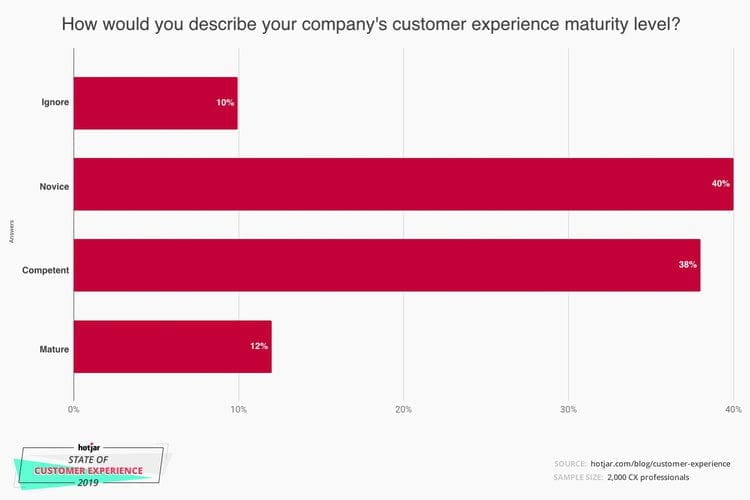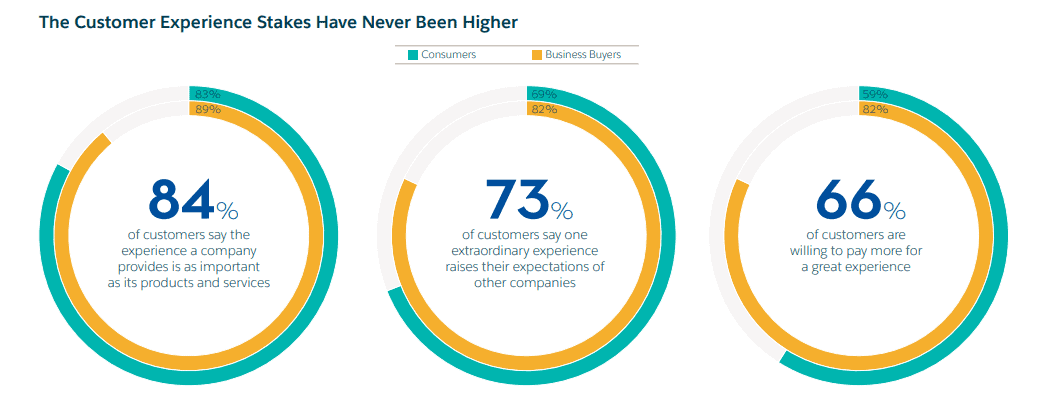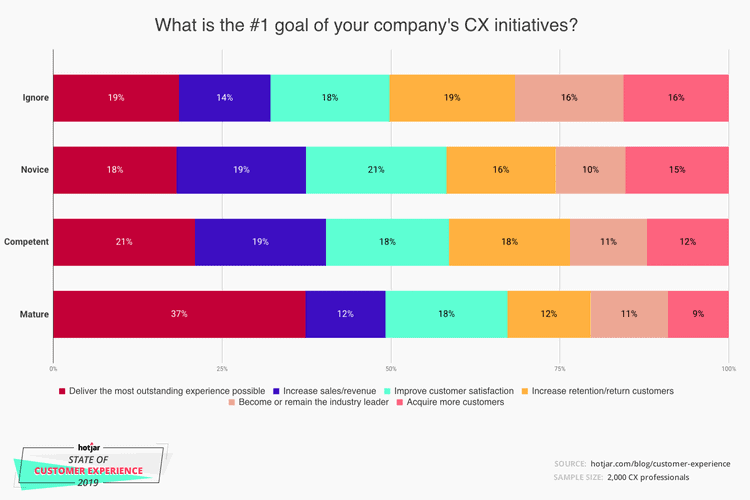Some say, “Experience, schmerience” like it’s still 1999. It’s not. Today, customer experience (CX) is fast becoming the number one business differentiator. It’s driving loyalty, revenue, profits, growth – and improving customer experience needs to be right at the top of your organizational priorities.
What’s So Important About Improving Customer Experience?
In January 2020, Hotjar published the results of its State of Customer Experience survey of more than 2,000 CX professionals from across the globe. Respondents were asked to categorize their organizations into one of four levels of CX maturity: Ignore, Novice, Competent, or Mature.
The Ignore group (representing 10% of respondents) consists of the experience-schmerience nay-sayers – they don’t believe that improving customer experience is important and make no effort to do so. Novices (40%) recognize the need to improve customer experiences, have taken a few basic steps to identify areas where such improvements can be made, but have yet to implement a clear strategy for execution. The Competent cohort (38%) are already well underway with their CX strategies, are actively making efforts to deliver high-quality customer experiences, and have processes in place to measure results. Finally, Mature companies (12%) have a CX strategy that is embedded in everything they do – CX informs all decision-making, and they continuously aim to refine their CX practices in line with customer demand.

(Image source: hotjar.com)
The first thing that Hotjar’s data tells us is that the nay-sayers are in the minority. A full 90% of organizations today are aware of the importance of competing based on customer experience. Only 10% are ignoring the CX imperative – and it seems these companies are paying the price for their ignorance.
Indeed, CX professionals whose companies are leading the CX field report much higher revenues than their counterparts. How much higher? Well, 42% of Mature companies record an annual turnover of over $100 million, while almost half (49%) of Ignore companies make less than $1 million a year.

(Image source: hotjar.com)
Why should this be? Simple – customers today care more about experiences than they have done at any other point in history.
We know this from a number of consumer surveys that have been conducted over recent months. Take Salesforce’s State of the Connected Customer (Third Edition) report, for instance – a survey that gathered insights from 8,000 consumers and business buyers worldwide. It finds that CX is now paramount, as the vast majority (84%) of customers say that the experience a company provides is just as important as the products or services it offers. What’s more, 66% of customers are willing to pay more for a better experience, and – crucially – nearly three-quarters (73%) say that an extraordinary experience from one company raises their expectations of other companies. In other words, customer experience is the new competitive battleground upon which customers are won and lost.

(Image source: salesforce.com)
A separate report from Merkle – The Experience Impact – which polled 500 US consumers confirms the findings.
The research revealed that a full one-third (66%) of consumers care more about the experience than price when choosing a brand from which to make a purchase. Additionally, over half (52%) of shoppers reported having stopped shopping on a brand website due to a poor experience. And here’s something else of note. Nike, Amazon, and Apple were cited as the top-mentioned brands for delivering exceptional customer experiences – and since customers are no longer just comparing like-for-like competitors anymore (but rather their experience with one brand against all others, regardless of category), all companies operating today have the experiences offered by these customer-centric powerhouses to live up to.

(Image source: merkleinc.com)
Improving Customer Experience
By now we can be certain that CX matters – big time. However, the Salesforce survey reveals a worrying trend – namely, that companies aren’t living up to customers’ expectations. This means that companies aren’t focusing on improving customer experience enough. Despite high expectations for things like personalized engagement, most companies still fail to truly understand individual customers’ needs and expectations. As a result, over half (51%) of consumers say that the companies they do business with are failing to meet their CX expectations.

(Image source: salesforce.com)
As the report’s authors put it: “Customers expect to be treated as people rather than personas. Like with friendships, customer relationships bloom when individuals feel understood. But when customers feel like their needs aren’t appreciated, even after multiple interactions, relationships can weaken. Expectations for personalized engagement span generations, rebutting outdated strategies aimed at broad segmentations and challenging companies to learn more about individuals. Yet companies haven’t caught up, with relatively few understanding customers’ needs and expectations – let alone adapting to their actions and behavior.”
What Is Customer Experience?
Before we go any further, let’s just take a moment to define exactly what we mean by customer experience. Gartner defines customer experience as “the customer’s perceptions and related feelings caused by the one-off and cumulative effect of interactions with a supplier’s employees, systems, channels or products.” Forrester puts it even more succinctly: “How customers perceive their interactions with your company.”
Both definitions highlight “interactions.” So, what are these exactly? Forrester once more: “When customers navigate your website, call into your contact center, go into your retail location, talk to one of your employees, buy your products, use your products, respond to your emails” – all of these (and more besides) are interactions, and are the moments when customers are “making judgments about whether or not you meet their needs, are easy to do business with, and are enjoyable to do business with.” These interactions, Forrester says, are when people are having an actual customer experience.
CX is the result of every interaction a customer has with your business. It is your customers’ holistic perception of the experience with your business and brand. Improving customer experience, then, means improving the interactions customers have with your company. And in today’s hyper-connected world, interactions take place across a growing number of channels – websites, social media, physical stores, mobile, email, messaging services, sales calls, marketing materials, customer service – all of which must be connected with a keen eye for delivering personalized experiences that treat customers like the individuals they are. As such, everything from information access to corporate ethics, emerging technologies, peer reviews, and product choice are important elements of a superior customer experience for today’s customers, as revealed in the following data from the Salesforce survey.

(Image source: salesforce.com)
How, then, can organizations go about developing a strategy for improving customer experience interactions across the board?
How to Develop a Strategy for Improving Customer Experience
Develop a Customer-Centric Mindset and Culture
The first and most crucial thing to realize is that customer experience no longer begins (or ends) with a customer service call. Many people still use the terms “customer service” and customer experience” interchangeably – and they shouldn’t. While customer service is an important part of customer experience, it’s only one piece of the puzzle – only one interaction a customer has along their journey with a company. As I hope it is clear by now, customers expect personalized, convenient, and rewarding experiences across all channels and touchpoints – including, yes, but not limited to, the customer service channel.
This means that strategies for improving customer experience must encompass the whole customer lifecycle from start to finish – and not just be limited to the customer service department. It involves developing a customer-centric mindset that permeates throughout the entire organization – from product to marketing to sales to customer service. In other words, improving customer experience means getting every department involved.
And the proof is in the pudding. Harking back to Hotjar’s survey (the one that revealed that companies leading in CX maturity enjoy revenues many times higher than those who are ignoring customer experience), we see that the primary focus of more than one-third (37%) of Mature companies is on delivering the most outstanding experiences possible – more than any other goal, including increasing their bottom line.

(Image source: hotjar.com)
We also see that four out of ten (41%) Mature companies view themselves as customer-centric, a 2.5X increase over Ignore companies (17%). And here’s the thing – while the largest proportion of companies who view themselves as profit-centric are Ignore companies (22%), it is the smallest proportion (Mature companies (9%)) that are, in fact, achieving the highest revenues.

(Image source: hotjar.com)
The long and the short of it is that we are seeing companies who prioritize experience over profits demonstrating higher revenue growth. As such, in order to mimic this success, a shift in both mindset and culture will likely be required. This will inevitably be a top-down initiative. As you aim to develop and implement new CX improvement programs that span the whole customer journey – and thereby require the buy-in from multiple departments – strong leadership will be fundamental to success. A new role may even be necessary to spearhead the culture change – such as a Chief Customer Experience Officer or Customer Experience Manager – whose job it will be to work with other members of the C-suite to oversee all actions and initiatives and ensure customer-centricity starts getting baked into everything your organization does and is.
Journey Mapping
Developing a mindset is one thing, but implementing real-world strategies is another. So, where to begin your culture-shifting, company-wide initiative for improving customer experience?
As we realize, any tactics deployed must encompass the whole customer journey – and so mapping that journey from start to finish is inevitably the most sensible place to start. We call this process journey mapping.
The important thing to realize right off the bat, however, is that no two customer journeys will ever be the same. One customer may first discover your brand via social media, engage with your online marketing materials, be flagged up as a hot lead by your CRM system, and end up receiving a sales call from your sales team. A colleague or friend may have referred another and so picked up the phone themselves. And still, another might simply find your website via a Google search.
Journey maps outline every step your customers go through along each potential path they can possibly take when interacting with your company. They often take the form of infographics, diagrams, or charts so your team members can actually visualize all the touchpoints where customers come into contact with your brand – online and off, both before and after purchase. Below is a graphic from MindTools showing an example of what a customer experience map might look like for someone purchasing software.

(Image source: mindtools.com)
In such a way, journey maps help you gain the helicopter view of customer journeys through the lens of the customer. They help you answer crucial questions: Why are there seven steps between point A and point B on your website when there should be only one? Why is customer service getting so many calls about this one particular issue? Where are the roadblocks that are negatively affecting the experience?
Ultimately, the goal of journey mapping is to map out your current processes – from the first to final interaction – to see if customers are reaching their goals, and, if not, how you can improve those interactions so they can.
Gathering Data
Importantly, journey maps should not only consider how customers interact at each stage of the journey, but how they feel during those interactions. Remember, improving customer experience ultimately equates to how customers feel about your brand – so gathering this information is crucial.
Hubspot provides a collection of customer journey map templates, which provide an example of how this information might be recorded.

(Image source: hubspot.com)
Organizations have many tools at their disposal for capturing and analyzing customer sentiment, including online surveys and interviews. Gathering feedback from real prospects and customers is crucial to understand precisely where your opportunities are for improving customer experience, identifying customer motivations, and ultimately removing areas of friction and increasing positive touchpoints. So, conduct CX surveys to find out how customers feel about their experiences with your brand.
Important questions include:
- On a scale of 1 to 10, how easy was it to find the information you were looking for on our website? If you feel there was any information missing, what was it?
- Have you ever made a purchase with us? If so, what was the deciding factor?
- Have you ever interacted with our site with the intention of making a purchase but decided not to? If so, what led you to this decision?
- Have you ever required customer support? If so, how helpful was it on a scale of 1 to 10, and what specifically do you feel could be improved?
Even more data can be captured from each customer at other touchpoints. Any time a customer sends an email, calls customer support, or leaves a review – that’s all-important feedback that should be gathered and analyzed. Social media channels will also surface vital clues into how customers feel about your company – and social monitoring tools can be used to gather the data and dig into it. Elsewhere, advances in customer service technology such as speech analytics that can provide analyses of contact center recordings can also help you identify pain points that can be added to your customer journey map for actioning.
Importantly, you should also conduct surveys with your internal teams. Customers interact with every part of your business, and each department will have their own unique perspective on how to improve the customer experience. Marketing, for example, will be sitting on a treasure trove of information on how prospects are finding your business, what materials they’re engaging with, and what paths they’re taking on the lead up to a sale. Sales, meanwhile, will have the insights into the challenges your customers are facing and how they expect your product or service to solve them. They will also have information on what’s preventing certain leads from being converted into customers, and can this way help you determine what may be missing from your marketing materials. Elsewhere, your customer service department will be hearing first-hand feedback and frustrations from real customers on a daily basis – this is golden information for identifying areas for improving customer experience.
Putting it all together, you can start to fill out a detailed customer journey map that can be used to identify opportunities for tearing down roadblocks and streamlining customer journeys. A great example is this one from the app development company Bright Vessel. It outlines the five steps the company believes customers go through when interacting with them, along with the emotions they’re feeling, and what steps Bright Vessel needs to take to solve their problems along the journey.

(Image source: brightvessel.com)
Final Thoughts
All business models can benefit from improving the customer experience. Subscription businesses such as SaaS can increase retention and reduce churn, eCommerce sites can increase order values and repeat custom, and service industries can gain recommendations and reduce complaints. While there is no universal checklist to follow to guarantee good customer experience, listening to customers is clearly a top priority. Feedback must then be gathered, analyzed, and acted upon regularly. Building customer journey maps will help you visualize all paths to purchase, identify roadblocks, and understand customer sentiment at each stage of the funnel. All of this should be used to reduce friction wherever possible as you continuously aim to build a customer-centric company culture where improving customer experience is the number one aim.
Summary:
Improving Customer Experience
Improving customer experience is crucial today. A separate report from Merkle – The Experience Impact – which polled 500 US consumers confirms the findings. The research revealed that a full one-third (66%) of consumers care more about the experience than price when choosing a brand from which to make a purchase. Additionally, over half (52%) of shoppers reported having stopped shopping on a brand website due to a poor experience. This means that companies aren’t focusing on improving customer experience enough. Despite high expectations for things like personalized engagement, most companies still fail to truly understand individual customers’ needs and expectations. As a result, over half (51%) of consumers say that the companies they do business with are failing to meet their CX expectations. This means that strategies for improving customer experience must encompass the whole customer lifecycle from start to finish – and not just be limited to the customer service department. It involves developing a customer-centric mindset that permeates throughout the entire organization – from product to marketing to sales to customer service. In other words, improving customer experience means getting every department involved. The long and the short of it is that we are seeing companies who prioritize experience over profits demonstrating higher revenue growth. As such, in order to mimic this success, a shift in both mindset and culture will likely be required. This will inevitably be a top-down initiative.
